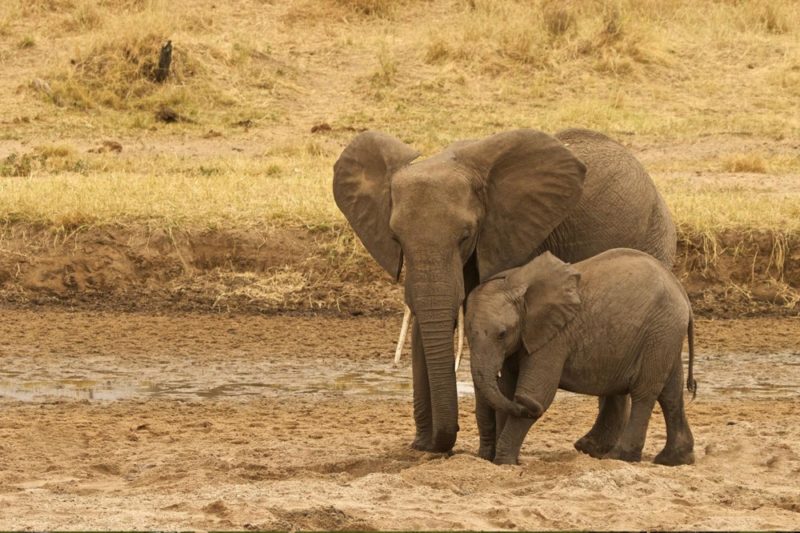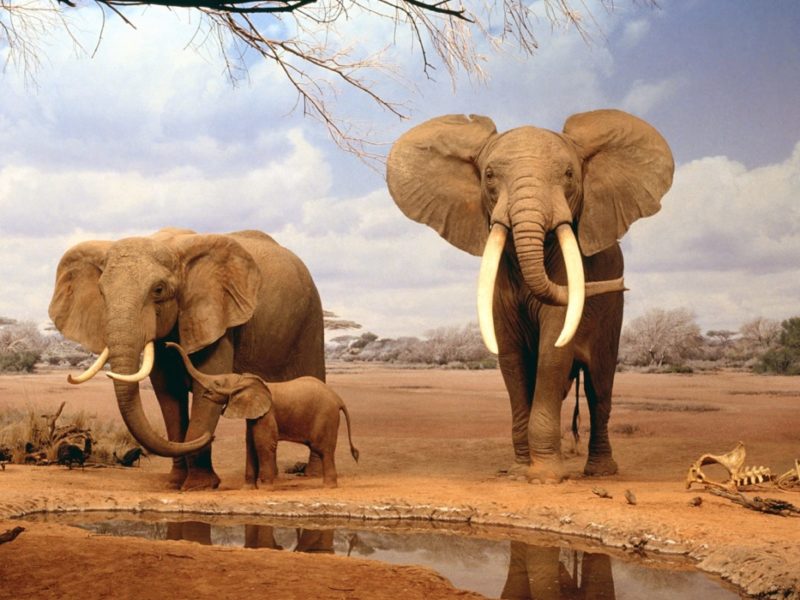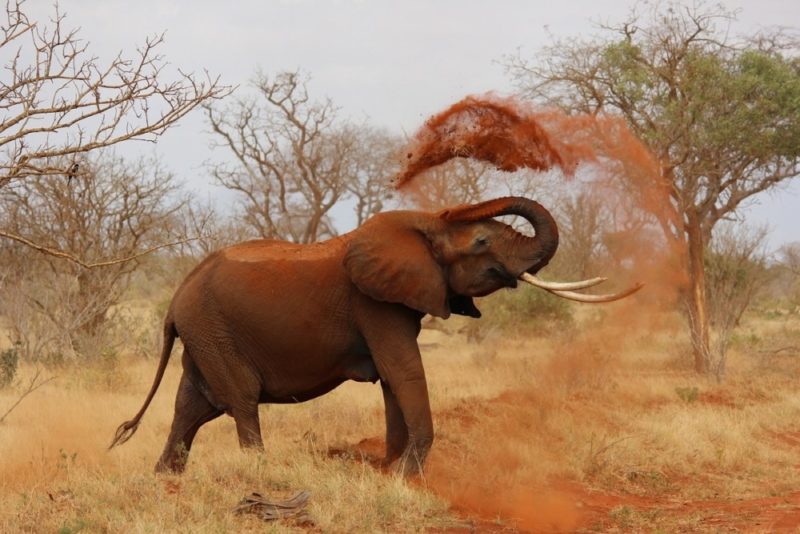The huge and majestic African elephant a few decades ago could completely disappear from the face of the earth. The ban on hunting and the creation of national reserves on the African continent saved from the catastrophe. People have the opportunity to better know this unique animal.
Material Content:
Description of the genus and species of the African elephant
In Africa, there are forest and savannah elephants. They differ from the Indian species in the structure of the skull, body size and tusks in both sexes. The isolation of East African elephants into a third separate species has not yet been resolved.
Forest elephants live in the humid tropical and equatorial jungles of Africa. They consume less water due to the abundance of juicy greens and fruits in the diet, looking for sources during a drought. Such an elephant is smaller than the savannah; its maximum height is 2.4 meters. These two species were divided, according to scientists, about 2.5 million years ago.
The savannah elephants have a huge body with a large head and a long trunk. These terrestrial mammals are second to none. They have large ears and limbs, reminiscent of centuries-old trees. The upper incisors turned into powerful tusks that continue to grow throughout life. The body length is about 6.5 m, the height is 3-4 m, the average weight of males is 8 tons, the females are a bit “more elegant”.
Terrestrial mammal habitat
Elephants inhabit the territories of reserves south of the Sahara desert. Around the 5th century AD e. they still met in the north of the mainland. Now the area of distribution has decreased by about 6 times, amounting to about 5 million km2.
Animals mastered places with a diverse landscape, experts even managed to describe desert elephants.In search of edible greens, herds go huge distances, can move tens of kilometers from sources of fresh water. During long trips, they perfectly remember the location of the oases, drawing up an accurate map of the area for themselves in their heads.
Lifestyle & Nutrition
The herd travels all the time in search of new places where there is food and water. Animals need a lot of vegetation, rich in fiber, vitamins and minerals. They need salt, which is obtained from mineral salt springs, sometimes digging them underground.
Elephants like any plant food. They eat grass, branches of trees and shrubs, fruits and cereals. One adult needs about 200 kg of greens per day. When times of famine come, a large herd is divided and families seek food separately. In the drought season, scattered groups meet again at the watering hole. If there is no rain for a long time, food in Africa becomes scarce, animals cannot satisfy their hunger. Then they have to migrate in search of green pastures and ponds, because they can only live 4 days without water.
Giants are wary of approaching places inhabited by people. Peasants kill animals, protecting their fields. Poachers hunt for tusks; several dozen animals die every day because of this. Elephants can walk very quietly: pads on the feet muffle the steps. If there is a farm or village on the way, they prefer to pass by silently at night.
The elephant family adheres to matriarchy in social groups. Animals entrust the role of leader of the herd to an experienced and savvy elephant. She must successfully cope with the solution of pressing issues - the search for food, drinking water, the protection of young offspring from predators. In ancient times, one herd could number up to 400 elephants, now these are small groups, counted in units or dozens of individuals. Under the guidance of the older female is her whole family, consisting of young and adult daughters. The male half leaves the herd at 10–13 years old and wanders alone or in small groups.
Quarrels in the herd are rare. Aggression is most often shown by adult males during fights for a female. With long tusks, they can inflict deadly wounds on each other.
Breeding and offspring
In nature, reaching 20 years old, males gather in a group of young elephants. They will compete with each other, trying to win the attention of a potential girlfriend. Sometimes the elephants have a period of extreme sexual arousal - must, when during the search for a partner blood rages from the developed testosterone. Elephant height affects the choice of a female; usually she prefers the largest male. Noticing courtship, elephants give their consent to a grunt, and only 2-3 days show their interest in mating.
Elephant pregnancy lasts almost 2 years (20–22 months). The baby elephant is born fully formed and can immediately follow the mother, who moves in search of food. Every day, the baby has to travel long distances, while in a hurry, because if he lags behind the herd, he will not be able to survive.
The elephant takes care of the cub 10–13 years after birth, and then releases into adulthood. Females remain and travel in search of food with their mother, and males, having reached puberty, live separately. Almost a third of elephants die in the first year of life. Interestingly, the females take care of the cubs together. At the head of the herd is always an elephant - the grandmother of a large family. It is she who helps to breed offspring. The family does everything possible to protect the baby from predators, poachers and other dangers.
Soon after his birth, the African elephant reaches a weight of 90 kg. He drinks 11 liters of milk per day. In order for the baby to have enough milk, the mother must eat up to 17 hours a day. Other members of the herd help keep an eye on the baby. Usually these are elephants aged 2 to 12 years.The more babysitters, the greater the chances of survival. Lions and tigers also kill elephants, but a herd of adult animals stands up for posterity and chases away predators.
Life span
The huge savannah elephant is a long-lived, he lives on average 70–80 years. Usually molars fall out in an animal by this age and then death from exhaustion occurs. An elephant grows all its life, its age can be approximately determined by the size of the body and the length of the tusks.
The cause of death in nature are diseases, injuries and accidents. Large predators prey on elephants under 2 years old. Some African countries allow licensed sporting elephant hunting.
The size of the African elephant
The total number of animals over the past 200 years has declined significantly. At the beginning of the 19th century, there were about 27 million of them in Africa. By the 20th century, the population had decreased to 300–400 thousand individuals. In the late 80s, the ivory trade and hunting were officially banned, and national reserves were created.
According to recent studies, the number of African elephants is 500-600 thousand heads. The animal is listed in the Red Book as a vulnerable species (the status of "endangered" was changed in 2004). Contraction of wild territories by people, extermination by poachers contributes to population reduction. Native lands, inhabited by animals for millions of years, become unsuitable for life due to the destruction of vegetation, the destruction of ecosystems.
Interesting facts about the animal
Elephants are able to empathize and understand the feelings of relatives. They have self-awareness, they recognize themselves in the mirror, have a good memory. They are smart and can use the simplest tools to achieve their goals.
It is noteworthy that animals that met after separation greet each other with shouts and shrugging trunks, cross tusks, pat their ears, rub their sides and urinate. The greeting ceremony after a long break-up can last 10 minutes.
With poor eyesight, these individuals perfectly distinguish smells and sounds. When communicating using touches of each other, visual and sound signals. The screams of elephants are heard over a distance of 10 km due to infrasound components.
Massive physique and huge weight does not prevent the giants from developing speed while running up to 40 km / h. Giants are able to swim perfectly and cross the reservoir along the bottom, exposing only the trunk from the water. On land they prefer to move at a speed of 2 to 6 km / h, overcoming 12 km per day. In the migration season, a distance of 500 km may have passed.
Elephants sleep standing, huddled together by huge bodies, which makes them invulnerable to large predators. The duration of sleep is only 40 minutes. For a day, animals spend about 17 hours on food, 3 hours on sleep, the same amount on transitions and 1 hour takes other activities.
The survival of African elephants depends on the conservation of their natural habitat. Many more generations of people will be able to admire the magnificent giants, admiring this miracle of nature.
















